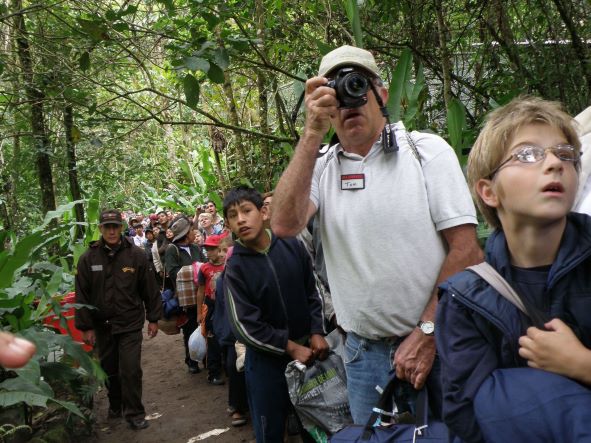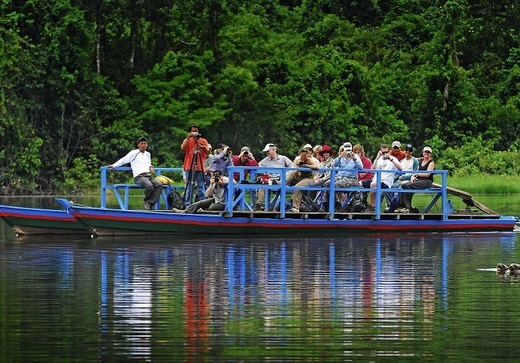The Peruvian Amazon is never shown so openly as in the Manu National Park, a Natural Heritage of Humanity.
Everything seems to be found here in its purest form: 221 species of mammals, thousands of birds, and the entire range of climates from the lowland rainforest to the frigid highlands of over 4000 m s. n. m. In addition, the Manu is home to native populations that preserve their traditions; some are completely isolated on a voluntary basis.
Still with secrets to discover, what Manu shows us is as wonderful as it is unforgettable.
Manu National Park


The Manu National Park is located in the provinces of Paucartambo in Cusco and Manú in Madre de Dios. Its extension is 1716295.22 hectares. Its establishment seeks to protect a representative sample of biological diversity, as well as the landscapes of the low jungle, the jungle browbone and the Andes of southeastern Peru. Likewise, it is intended to promote tourism based on ecological and culturally compatible criteria.
On the other hand, the Manu National Park also seeks to promote and facilitate research, education and recreation, as well as to contribute to the preservation of archaeological heritage. Their presence contributes to the recognition and protection of cultural diversity, as well as to the self-determination of the indigenous peoples of the area.
The Manu National Park protects one of the most important areas of the planet in terms of the mega diversity of biological species. Its great extension crosses frigid highlands —which exceed 4,000 meters above sea level—; rugged forested mountains that give rise to a multitude of small streams and valleys; cloud forests of high jungle and finally the Amazon plain. This magnificent and unique setting includes a wide and complex hydrographic system and guarantees the presence of a diversity of ecosystems little intervened by man.
Since 1977 the Manu National Park has the status of a Biosphere Reserve, which was granted by UNESCO. In its borders is the Territorial Reserve of the Kugapakori and Nahua ethnic groups, the Megantoni National Sanctuary and the Amarakaeri Communal Reserve. In turn, in 1987 it was declared a Natural World Heritage Site.
Much of the Manu National Park is indigenous territory. The communities of the Yora, Mashko-Piro, Matsiguenka, Harakmbut, Wachipaeri and Yine ancestrally inhabit the forests and rivers of these jungles. The native communities of Tayakome and Yomibato are recognized within the area. Both are located in the upper area of the Manu River. In the southwest sector there is an association of farmers known as Callanga. Furthermore, in the northwestern sector adjacent to the Manu National Park (and in the interior) there is an undetermined number of indigenous populations in voluntary isolation.
Your visit is highly recommended, if not mandatory.
Location:
The park is located in the provinces of Manu and Paucartambo (Departments of Madre de Dios and Cuzco, respectively), encompassing the eastern slopes of the Andes in the Peruvian Amazon.
Manu National Park Facts
Here we mention 6 Manu National Park Facts that will convince you to visit this magical site.
- Created on May 29, 1973 and considered one of the protected natural areas in Peru.
- Located in the provinces of Paucartambo in Cusco and Manu in Madre de Dios, the Manu National Park has an area of 1,716,295.22 hectares and occupies the entire basin of the Manu River.
- It is the residence of more than 30 native communities, who fight daily to preserve their home and at the same time warmly welcome tourists.
- With respect to the animals in Manu National Park, it was identified that 222 species of mammals inhabit the Manu National Park; 1,005 types of birds, more than 50 species of snakes, 40 of lizards, 6 of turtles, 3 of alligators and 210 types of fish.
- It has the world record for diversity of amphibians and reptiles, 155 and 132 species, respectively.
- There is evidence of 4,385 identified species of flora in the Manu National Park. In just one hectare of territory, you can find up to 250 varieties of trees.
Climate in Manu National Park
The climate in Manu National Park is highly variable. The climate in Manu National Park is generally very rainy and the precipitations vary according to the altitude. In the southern zone (which is the highest), 1,500 to 2,000 mm are recorded annually. In the middle sector it increases from 3,000 to 3,500 mm. The highest record is reached in the northwest sector with more than 8,000 mm.
In the dry season, from May to September, rainfall decreases and the temperature drops. The thermal regime is also highly variable, since the Amazon area is warm, with an average annual temperature of 25.6 ° C, and the Andean area is cold with an average annual temperature of 8 ° C.
Animals in Manu National Park
The Manu National Park is home to a large number of animals of wildlife. It has registered about 160 species of mammals, more than 1,000 species of birds (mostly residents), about 140 species of amphibians, 50 species of snakes, 40 of lizards, 6 of turtles, 3 of alligators and 210 of fish.
On the other hand, the number of insects in the Manu National Park is very high. It is estimated that there are about 30 million species. In turn, more than 1,300 species of butterflies, 136 of dragonflies, at least 300 of ants (more than 40 species were found in a single tree) and more than 650 of beetles have been recorded.
A total of 500 birds only around the lowland forests at the Cocha Cashu Biological Station, and the checklists of Terborgh, Janson and Brecht (1984) give habitats, foraging position, activity (sociability) and abundance of all birds and mammals found up to 1982. The bird species found in the Manu represent 25% of all known birds in South America and 10% of all species in the world and it is thought that it may more than 1,000 species of birds in total. According to Renton (1990), six species of macaws occur in lowland forests, Ara ararauna, A. chloroptera, A. macao, A. severa and A. manilata.
There are 13 species of monkeys, and it is estimated that there are more than 100 species of bats. There are also 12 species of reptiles within 7 families (ANU-CEPID, 1986), and 77 species of amphibians from the fire families are known from the Cocha Cashu area (Rodríguez, in press). There are no checklists for invertebrates, although the park has been estimated to contain some 500,000 species of arthropods. Again, most of the information has been collected in the lowlands, and little detailed information about animals in Manu National Park is available.
Flora in Manu National Park
With regard to the flora of the Manu National Park, the number of plant species is very high. The various records indicate that there are at least 162 families, 1,191 genera and 4,385 identified species. In a single hectare, up to 250 varieties of trees were found. The aguajales forests are one of the most outstanding ecosystems, where the aguaje (Mauritia flexuosa) and huasaí (Euterpe precatoria) palms are the dominant ones. They develop on almost permanently flooded areas, especially on the right bank of the Manu River.
Tourist Routes
In the lower basin of the Manu River you can see the exuberance of the Amazonian plain. Five zones have been designated for the visit, where a high diversity of flora and fauna is concentrated, these are: Salvador, Otorongo, Juárez (these three are lakes), Pakitza and Limonal.
In these areas there is a great variety of circuits and trails to appreciate the beauty of the tropical forest. There are also horseshoe-shaped lakes or lakes where it is possible to observe species that have disappeared in other ecosystems, such as the river wolf and the black lizard.
Another attraction is the forests on both banks of the Manu River, where it is not only possible to observe a great variety of flora, but also numerous associated fauna. A landmark of attraction are the clay licks, where many species of fauna come. The aguajales also allow the concentration of typical fauna, such as macaws.
How to get to Manu National Park from Cusco
You can get to Manu National Park from Cusco in two ways: hiring a travel agency or by your own.
Hiring a tour
The safest option to get there is hiring a tour to Manu National Park from Cusco. Apart from not having to worry about where to go and having adequate vehicles to travel the difficult roads into the jungle, the tours work with multi-day itineraries that include accommodation, meals and activities such as zipline, canopy, walks and rides in boat. In addition, the tours stop at specific places on the route where urban transport does not. One of these stops is in the cloud forest, where it is possible to observe the fascinating courtship dance of the Gallito de las Rocas.
Arrive on your own
To arrive to Manu National Park from Cusco on your own you must go to the San Jerónimo control in Cusco, from here combis leave at 11 in the morning or at 5 in the afternoon to Pilcopata, within the cultural zone of Manu. The trip takes about 7 hours. You can also take the combi directly to Salvación, which is one hour further in from Pilcopata. The first trip has a cost of 30 soles per person, and up to Salvation of 40 soles per person. An accommodation option in Pilcopata is the Gallito de las Rocas Lodge, with a cost of 15USD per night.










